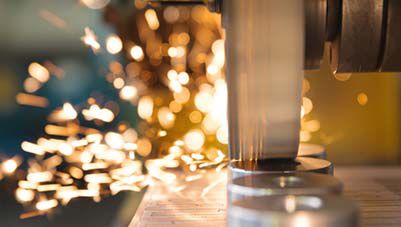An injection moulding machine is a manufacturing device used to produce plastic components by injecting molten material into a mould. The process is widely used in the mass production of identical items such as automotive parts, packaging, electronic housings, and consumer goods. It offers high precision, efficiency, and the ability to work with various thermoplastics and thermosetting polymers.
What is an injection moulding machine?
An injection moulding machine is a specialised machine used to make plastic parts. It melts plastic pellets, forces the molten plastic into a carefully shaped mould under high pressure, and then cools it to form the final product. This process allows fast and precise mass production of items such as car parts, electronics, and everyday plastic goods.
Construction of injection moulding machine
The construction of an injection moulding machine consists of several essential parts that work together to shape the final product:
- Injection unit – melts and injects the plastic material into the mould
- Clamping unit – holds the mould halves tightly during injection
- Mould – custom-shaped cavity where the molten plastic solidifies
- Hydraulic or electric drive – powers the movement of injection and clamping mechanisms
- Control system – manages temperature, pressure, and cycle timing
These components ensure precise shaping and efficient operation.
How does an injection moulding machine work?
The working process of an injection moulding machine involves several key steps:
- Clamping – the two halves of the mould are closed and securely clamped
- Injection – molten plastic is injected into the mould cavity
- Cooling – the plastic solidifies as it cools in the mould
- Mould opening – the mould opens once the plastic solidifies
- Ejection – the finished part is ejected from the mould
This cycle repeats rapidly, making the process ideal for high-volume manufacturing.
Components of an injection moulding machine
Understanding an injection moulding machine involves looking at its main parts, each of which plays a key role in turning plastic pellets into finished products.
Injection Unit
- Hopper: The entry point for plastic pellets, which are the raw material. This is where the process starts.
- Barrel: A heated section where the pellets are melted with the help of heating bands.
- Heating Bands: Wrap around the barrel to provide the heat needed to melt the plastic.
- Screw: Mixes the molten plastic to make it uniform and pushes it into the mould.
- Nozzle: Directs the molten plastic from the injection unit into the mould cavity accurately.
Clamping Unit
- Mould: Custom-designed to shape the molten plastic into the desired product.
- Clamping System: Holds the mould halves tightly during injection and cooling.
- Ejector System: Pushes out the finished product once it has cooled and solidified.
Control System
- Control Panel: Acts as the machine’s “brain,” allowing operators to set and monitor temperature, pressure, cycle time, and other parameters.
Hydraulic System
- Pumps and Motors: Provide the power needed for actions such as opening/closing the mould and injecting plastic.
- Valves and Hoses: Control hydraulic fluid flow for precise machine movements.
Cooling System
- Cooling Channels: Inside the mould, these channels circulate coolant to help the plastic solidify quickly.
Safety Features
- Safety Gates: Prevent access to moving parts during operation, keeping operators safe.
- Emergency Stop Buttons: Allow the machine to be stopped immediately in an emergency to protect both operators and equipment.
Defects of injection moulding machine
Common defects that can occur in the injection moulding process include:
- Flow lines – visible lines due to uneven flow
- Burn marks – caused by trapped air or overheating
- Warping – uneven cooling leads to deformed shapes
- Short shots – incomplete filling of the mould
- Sink marks – depressions due to excessive cooling
Understanding these defects helps with process optimisation and quality improvement.
Different types of injection moulding machines
There are several types of injection moulding machines, each suited for specific applications:
- Hydraulic injection moulding machine
- Electric injection moulding machine
- Hybrid injection moulding machine
- Vertical injection moulding machine
- Multi-material injection moulding machine
Each machine type offers unique advantages in terms of speed, precision, and energy efficiency. Check your pre-approved business loan offer to explore convenient funding options for upgrading to advanced machinery.
Injection moulding machine process parameters
Important process parameters in injection moulding include:
- Injection pressure
- Mould temperature
- Injection speed
- Cooling time
- Clamping force
Proper control of these parameters ensures product consistency, quality, and minimal waste.
Advantages of injection moulding machine
Key advantages of using an injection moulding machine are:
- High production efficiency
- Complex part design capability
- Consistent product quality
- Material versatility
- Automation-friendly
It is a preferred method in various industries for high-volume, precision manufacturing.
Disadvantages of injection moulding machine
Despite its benefits, the process has some limitations:
- High initial tooling costs
- Long lead times for mould design
- Limited to high-volume production
- Potential for surface imperfections
Understanding these helps businesses make informed investment decisions.
Injection Moulding Machine Cost
- Small / Entry-Level Machines: Around Rs. 95,000 to Rs. 2,00,000 for basic semi‑automatic or small units suitable for very light production or small parts.
- Budget Industrial Machines: Machines suitable for small- to medium-scale production often range from Rs. 5,00,000 to Rs. 15,00,000.
- Mid-Range Industrial Machines: Typical new industrial machines in the 100–120 ton class are usually priced about Rs. 18,00,000 to Rs. 45,00,000.
- Higher Capacity / Advanced Machines: Larger or more automated units (e.g., 300–400 ton class) can cost from roughly Rs. 85,00,000 up to Rs. 2,25,00,000 or more, depending on features and automation.
- Used Machines: Second-hand machines can also be an option, with prices often between Rs. 15,00,000 and Rs. 50,00,000+ depending on capacity and condition.
These prices vary widely based on clamping force, automation type (hydraulic/electric/hybrid), build quality, brand, and additional features like robotics or advanced control systems.
Applications of injection moulding process
Injection moulding is widely used across multiple industries:
- Automotive components
- Medical devices
- Consumer electronics
- Packaging materials
- Household products
Its versatility makes it an essential manufacturing technique.
Buying guide for injection moulding machine
When buying an injection moulding machine, consider the following factors:
- Clamping force requirements
- Injection capacity
- Machine type (hydraulic, electric, etc.)
- Energy efficiency
- After-sales support
- Price vs long-term ROI
For businesses exploring options, leveraging a machinery loan finance can ease upfront capital requirements.
Injection moulding machine financing options
To support investment in industrial equipment, businesses can explore various financing options such as:
- Term loans
- Lease financing
- Line of credit
- Custom EMI plans
For flexible solutions, industrial equipment finance can help manage costs efficiently while scaling operations.
Conclusion
An injection moulding machine is a cornerstone of modern manufacturing, offering precision, scalability, and versatility. While it comes with initial investment and operational considerations, its long-term benefits are substantial. Businesses looking to expand or modernise their production lines can also consider applying for a business loan to manage costs and ensure smooth scaling.
When evaluating funding options, it is important to compare business loan interest rate to ensure the financing remains cost-effective over the long run. Additionally, to plan monthly repayments more accurately, companies can make use of a business loan EMI calculator to estimate instalments based on loan amount and tenure.
Check out more related Industrial Equipment
Industrial Equipment |
||
|
||








